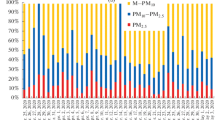Abstract
Results of measurements of the soot and fine aerosol mass concentration in the center of Moscow and at two points of the Zvenigorod Scientific Site (ZSS) in the spring–autumn periods of 2014–2016 are presented. The results are compared with data of complex measurements made during 1989–2013. Events where the increase in atmospheric air pollution by smokes from burning peat bogs in Bryansk oblast and smoke from burning trees infested by bark beetles in forests in Moscow region, as well as by forest fire smoke coming from Siberia, have been identified. The considerable increase in vehicle density during past 25 years near the ZSS measurement point located 150 m from a highway led to an increase in the level of air contamination by aerosol components by two or three times. At the second point, 1 km from the highway, the soot contamination level is comparable with data obtained in the 1990s and is approximately a third as high as in Moscow.
Similar content being viewed by others
References
G. S. Golitsyn, E. I. Grechko, A. V. Dzhola, A. S. Emilenko, V. M. Kopeikin, V. S. Rakitin, A. N. Safronov, E. V. Fokeeva, G. Wang, and P. Wang, “Studying the pollution of Moscow and Beijing atmospheres with carbon monoxide and aerosol,” Izv., Atmos. Ocean. Phys. 51 (1), 1–11. 2015
J. M. Dasch and S. H. Cadle, “Atmospheric carbon particles in Detroit urban area: Wintertime source and sinks,” Aerosol Sci. Technol. 10 (2), 236–248 (1989).
G. V. Rozenberg, “About the nature of aerosol absorption in the shortwave spectral region,” Izv. Akad. Nauk USSR, Fiz. Atmos. Okeana 15 (12), 1280–1291 (1979).
V. A. Petrukhin, V. A. Vishenskii, S. L. Avaliani, K.A.Bushtueva, E. V. Pushkareva, O. V. Salieva, S. G. Paramonov, O. V. Larionova, I. N. Ivanova, N. S. Esaulenko, and E. G. Semutnikova, Risk of People Disease due to Vehicle Pollution of the Atmosphere. Experience of the use of the risk assessment technique in Russia, Ed. by V. A. Petrukhin (Nauka, Moscow, 2000) [in Russian].
Handbook on Ecological and Climate Parameters in Moscow, Ed. by A. A. Isaev (MSU, Moscow, 2005), vol. 2 [in Russian].
V. M. Kopeikin, “Aerosol black carbon in the Moscow air,” Izv. Akad. Nauk, Fiz. Atmos. Okeana 34 (1), 104–110 (1998).
Isakov A.A., “On intra-annual variability of the mass concentration of the submicron near-surface aerosol in Moscow Region,” Opt. Atmos. Okeana 23 (6), 462–465 (2010).
G. I. Gorchakov, A. A. Isakov, I. I. Mokhov, M. A. Sviridenkov, K. A. Shugurov, A. V. Karpov, and A. V. Chernokul’skii, “Statistical parameters of variations in the mass concentration of submicron aerosol,” in Proceedings of the IV International Conference “Natural and Anthropogenic Aerosols,” Sankt Petersburg, Octo-ber 6–9, 2003 (NIIKh SPbGU, St. Petersburg, 2003), p. 499–503 [in Russian].
A. S. Emilenko and V. M. Kopeikin, “Comparison of synchronous measurements of soot and submicron aerosol concentrations in regions with different anthropogenic loadings,” Atmos. Ocean. Opt. 22 (4), 421–427 (2009).
V. S. Kozlov, M. V. Panchenko, and E. P. Yausheva, “Mass fraction of Black Carbon in submicron aerosol as an indicator of influence of smokes from remote forest fires,” Atmos. Ocean. Opt. 19 (6), 434–440 (2006).
M. V. Panchenko, S. A. Terpugova, M. A. Sviridenkov, and V. S. Kozlov, “Active spectral nephelometry as a method for the study of submicron atmospheric aerosols,” Int. J. Remote Sens. 29, 2567–2583 (2008).
M. A. Sviridenkov, Avtoref. of Doctoral Dissertation in Mathematical Physics (Institute of Atmospheric Optics SB RAS, Tomsk, 2008).
V. M. Kopeikin, Avtoref. of Candidate’s Dissertation in Mathematical Physics (Institue of Atmospheric Physics, Moscow, 1998).
S. L. Belousov and T. S. Pagava, “Calculation of Trajectories of Air Particles,” in Branch Fund of Algorithms and Programs “Hydrometeorology Service”, No. 257244 8.00150-0113 (INIIGMI-MTsD, Obninsk, 1998), p. 1–104 [in Russian].
https://doi.org/www.greenpeace.org/russia/ru/news/2014/10-10-2014-Bryansk_torf/. Cited October 10, 2014.
Author information
Authors and Affiliations
Corresponding author
Additional information
Original Russian Text © V.M. Kopeikin, A.S. Emilenko, A.A. Isakov, O.V. Loskutova, T.Ya. Ponomareva, 2018, published in Optika Atmosfery i Okeana.
Rights and permissions
About this article
Cite this article
Kopeikin, V.M., Emilenko, A.S., Isakov, A.A. et al. Variability of Soot and Fine Aerosol in the Moscow Region in 2014–2016. Atmos Ocean Opt 31, 243–249 (2018). https://doi.org/10.1134/S1024856018030089
Received:
Published:
Issue Date:
DOI: https://doi.org/10.1134/S1024856018030089




